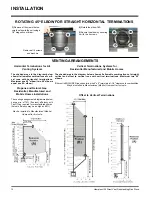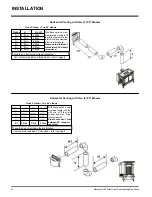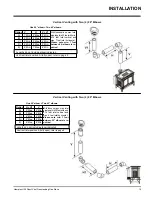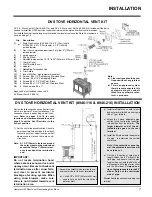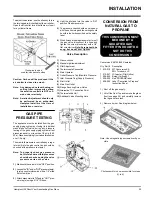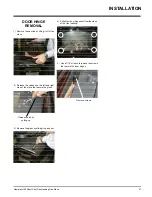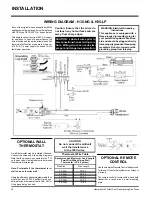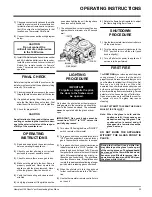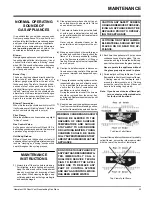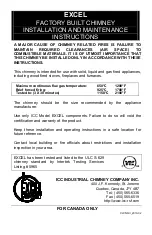
24
Hampton H35 Direct Vent Freestanding Gas Stove
AERATION
ADJUSTMENT
The burner aeration is factory set but may need
adjusting due to either the local gas supply, air
supply or altitude.
Natural Gas
1/4" (6.4 mm)
Propane
3/8" (9.5 mm)
The aeration adjustment gears are located on
the right side of the burner box. Remove the
Hampton Logo plate on the right side of the unit
to access the adjustment gears.
SYSTEM DATA - H35
For 0 to 4500 feet altitude
Natural Gas
Max. Input Rating 36,000 Btu/h
Min. Input Rating 18,000 Btu/h
Orifice Size #33 DMS
Convertible to:
Max. Input Rating 30,000 Btu/h
Min. Input Rating 14,300 Btu/h
Orifice Size #37 DMS
Propane
Max. Input Rating 34,000 Btu/h
Min. Input Rating 17,500 Btu/h
Orifice Size #51 DMS
Convertible to:
Max. Input Rating 28,500 Btu/h
Min. Input Rating 15,000 Btu/h
Orifice Size #52 DMS
Supply Pressure
Natural Gas
min.
5.0" w.c.
Propane
min.
12.0" w.c.
Manifold Pressure
Natural Gas
3.8"
+/- 0.2" w.c.
Propane
11"
+/- 0.2" w.c.
half of the flashing should be under the
shingles.
4)
Assemble the desired lengths of Black Pipe
and Elbows necessary to reach from the
appliance adapter up through the support
box and flashing to proper height as per
Dia. 12, local codes or page 10. Ensure that
all pipe and elbow connections are in their
fully twist lock position.
5)
Ensure vent is vertical and secure flashing
to the roof with roofing nails. Slide the
storm collar over the pipe section and seal
with a mastic.
6)
Twist lock the vent cap on to the last
section.
Support Extensions - Round
(RDSE)
or Square (SQSE)
Steep pitched cathedral ceilings may require
the use of a support extension. This piece fits
down inside the support and can be adjusted
to increase the support's length by up to 22".
The extension is attached to the support using
the eight metal screws provided. Be sure there
is at least a 2 inch overlap where the extension
joins the support.
HIGH ELEVATION
This unit is approved in Canada for altitude to 4500
ft. (CAN/CGA-2.17-M91). For Natural Gas instal-
lations above 4500 ft. follow current CAN/CGA-
B149.1.
GAS CONNECTION
The gas connection is a 3/8" NPT 90
o
elbow.
The gas line can be rigid pipe or to make
installation easier, use a listed flexible connec-
tor and/or copper tubing if allowed by local
codes. Since some municipalities have addi-
tional local codes it is always best to consult
with your local authorities and the CAN/CGA
B149 installation codes.
For USA installations follow local codes and/or
the current National Fuel Gas Code, ANSI
Z223.1.
When using copper or flex connectors use
only approved fittings. Always provide a union
so that gas lines can be easily disconnected for
burner and/or valve servicing. Flare nuts for
copper lines and flex connectors are usually
considered to meet this requirement.
IMPORTANT: ALWAYS CHECK FOR
GAS LEAKS WITH A SOAP AND
CATHEDRAL CEILINGS
Round Support (RDS) &
Square Support (SQS)
If your home has a cathedral ceiling (no attic
space between the ceiling and the roof), install
the chimney and support as follows.
1)
Situate the chimney in a convenient loca-
tion as near as possible to the appliance
outlet. Cut and frame a hole in the roof for
the support. The sides of this hole must be
vertical with 1 1/4" clearance.
2)
Place the support in the opening. Lower it
to the correct height as determined by the
table and diagram below.
Using a level, make sure the support is
vertical. If the support extends above the
roof, cut it flush with the top of the roof.
Nail the support to the frame opening
using (8) 3" spiral nails or #8 x 1-1/2"
screws.
Note: If you are using a 6" square sup-
port you may find it difficult to
screw it in place because it is fairly
small inside.
Simpson Dura-Vent has provided angle
brackets with this support which can be
screwed to the outside of the support box
and nailed to surrounding framing as re-
quired. Use a minimum of four #8 x 1/2"
screws per bracket. In some cases these
brackets may need to be trimmed (e.g.: to
fit under a flashing). Place the Finish
Collar around the support and fasten it to
the ceiling using the screws provided.
3)
Use appropriate roof flashing. Place the
flashing under the upper shingles and on
top of the lower shingles approximately
INSTALLATION
Slope
"X"
0/12
- 2/12
4"
2/12
- 7/12
5-1/2"
7/12
- 12/12
6-3/4"
12/12 - 24/12
7-1/2"
24/12+
12-1/2"
WATER SOLUTION OR GAS LEAK
DETECTOR. DO NOT USE OPEN
FLAME FOR LEAK TESTING.
Note: Prior to any pressure testing of
the gas supply piping system that
exceeds test pressures of 1/2 psig,
this appliance must be disconnect-
ed from the piping system. If test
pressures equal to or less than 1/
2 psig are used then this appliance
must be isolated from the piping
system by closing its individual
manual shut-off valve during the
testing.



